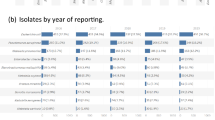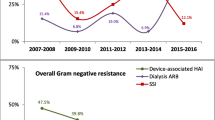Abstract
Purpose
In Japan, a national surveillance study of antimicrobial consumption has never been undertaken. This study aimed to describe antimicrobial consumption and resistance to Pseudomonas aeruginosa in 203 Japanese hospitals, to identify targets for quality improvement.
Methods
We conducted an ecological study using retrospective data (2010). Antimicrobial consumption was collected in the World Health Organization (WHO) anatomical therapeutic chemical/defined daily dose (ATC/DDD) format. Rates of imipenem (IPM), meropenem (MEPM), ciprofloxacin (CPFX), or amikacin (AMK) resistance were expressed as the incidence of non-susceptible isolates. Additionally, hospitals were asked to provide data concerning hospital characteristics and infection control policies. Hospitals were classified according to functional categories of the Medical Services Act in Japan.
Results
Data were collected from 203 Japanese hospitals (a total of 91,147 beds). The total antimicrobial consumption was 15.49 DDDs/100 bed-days (median), with consumptions for penicillins, carbapenems, quinolones, and glycopeptides being 4.27, 1.60, 0.41, and 0.49, respectively. The median incidences of IPM, MEPM, CPFX, and AMK resistance were 0.15, 0.10, 0.13, and 0.03 isolates per 1,000 patient-days, respectively. Antimicrobial notification and/or approval systems were present in 183 hospitals (90.1 %). In the multivariate analysis, the piperacillin/tazobactam, quinolones, and/or total consumptions and the advanced treatment hospitals showed a significant association with the incidence of P. aeruginosa resistant to IPM, MEPM, CPFX, and AMK [adjusted R 2 (aR 2) values of 0.23, 0.30, 0.22, and 0.35, respectively).
Conclusion
This is the first national surveillance study of antimicrobial consumption in Japan. A continuous surveillance program in Japan is necessary in order to evaluate the association among resistance, antimicrobial restriction, and consumption.
Similar content being viewed by others
References
World Health Organization (WHO). WHO global strategy for containment of antimicrobial resistance. 2001. http://whqlibdoc.who.int/hq/2001/WHO_CDS_CSR_DRS_2001.2.pdf. Accessed 1 Feb 2012.
Giske CG, Monnet DL, Cars O, Carmeli Y; ReAct-Action on Antibiotic Resistance. Clinical and economic impact of common multidrug-resistant gram-negative bacilli. Antimicrob Agents Chemother. 2008;52:813–21.
Izumida M, Nagai M, Ohta A, Hashimoto S, Kawado M, Murakami Y, Tada Y, Shigematsu M, Yasui Y, Taniguchi K. Epidemics of drug-resistant bacterial infections observed in infectious disease surveillance in Japan, 2001–2005. J Epidemiol. 2007;17:S42–7.
Rogues AM, Dumartin C, Amadéo B, Venier AG, Marty N, Parneix P, Gachie JP. Relationship between rates of antimicrobial consumption and the incidence of antimicrobial resistance in Staphylococcus aureus and Pseudomonas aeruginosa isolates from 47 French hospitals. Infect Control Hosp Epidemiol. 2007;28:1389–95.
Polk RE, Fox C, Mahoney A, Letcavage J, MacDougall C. Measurement of adult antibacterial drug use in 130 US hospitals: comparison of defined daily dose and days of therapy. Clin Infect Dis. 2007;44:664–70.
Goossens H, Ferech M, Vander Stichele R, Elseviers M; ESAC Project Group. Outpatient antibiotic use in Europe and association with resistance: a cross-national database study. Lancet. 2005;365:579–87.
Kuster SP, Ruef C, Ledergerber B, Hintermann A, Deplazes C, Neuber L, Weber R. Quantitative antibiotic use in hospitals: comparison of measurements, literature review, and recommendations for a standard of reporting. Infection. 2008;36:549–59.
Miliani K, L’Hériteau F, Lacavé L, Carbonne A, Astagneau P; Antimicrobial Surveillance Network Study Group. Imipenem and ciprofloxacin consumption as factors associated with high incidence rates of resistant Pseudomonas aeruginosa in hospitals in northern France. J Hosp Infect. 2011;77:343–7.
World Health Organization (WHO). WHO Collaborating Centre for Drug Statistics Methodology. ATC/DDD index. 2011. http://www.whocc.no/atc_ddd_index/. Accessed 5 Feb 2011.
Clinical and Laboratory Standards Institute (CLSI). Performance standards for antimicrobial susceptibility testing; Eighteenth informational supplement. CLSI document M100-S18, vol. 28. Wayne: CLSI; 2008.
Clinical and Laboratory Standards Institute (CLSI). Performance standards for antimicrobial susceptibility testing; Nineteenth informational supplement. CLSI document M100-S19, vol. 29. Wayne: CLSI, 2009.
Clinical and Laboratory Standards Institute (CLSI). Performance standards for antimicrobial susceptibility testing; Twentieth informational supplement. CLSI document M100-S20, vol. 30. Wayne: CLSI; 2010.
Pakyz AL, Oinonen M, Polk RE. Relationship of carbapenem restriction in 22 university teaching hospitals to carbapenem use and carbapenem-resistant Pseudomonas aeruginosa. Antimicrob Agents Chemother. 2009;53:1983–6.
Bantar C, Sartori B, Vesco E, Heft C, Saúl M, Salamone F, Oliva ME. A hospitalwide intervention program to optimize the quality of antibiotic use: impact on prescribing practice, antibiotic consumption, cost savings, and bacterial resistance. Clin Infect Dis. 2003;37:180–6.
Harbarth S, Harris AD, Carmeli Y, Samore MH. Parallel analysis of individual and aggregated data on antibiotic exposure and resistance in gram-negative bacilli. Clin Infect Dis. 2001;33:1462–8.
Miyawaki K, Miwa Y, Seki M, Asari S, Tomono K, Kurokawa N. Correlation between the consumption of meropenem or doripenem and meropenem susceptibility of Pseudomonas aeruginosa in a university hospital in Japan. Biol Pharm Bull. 2012;35:946–9.
Fukushima Y, Fukushima F, Kamiya K, Hayashi Y, Tatewaki M, Yamada I, Hirata H, Sugiyama K, Ishii Y, Fukuda T. Relation between the antimicrobial susceptibility of clinical isolates of Pseudomonas aeruginosa from respiratory specimens and antimicrobial use density (AUD) from 2005 through 2008. Intern Med. 2010;49:1333–40.
Muller A, Monnet DL, Talon D, Hénon T, Bertrand X. Discrepancies between prescribed daily doses and WHO defined daily doses of antibacterials at a university hospital. Br J Clin Pharmacol. 2006;61:585–91.
de With K, Bestehorn H, Steib-Bauert M, Kern WV. Comparison of defined versus recommended versus prescribed daily doses for measuring hospital antibiotic consumption. Infection. 2009;37:349–52.
López-Dupla M, Martínez JA, Vidal F, Almela M, Soriano A, Marco F, López J, Olona M, Mensa J. Previous ciprofloxacin exposure is associated with resistance to beta-lactam antibiotics in subsequent Pseudomonas aeruginosa bacteremic isolates. Am J Infect Control. 2009;37:753–8.
Falagas ME, Kopterides P. Risk factors for the isolation of multi-drug-resistant Acinetobacter baumannii and Pseudomonas aeruginosa: a systematic review of the literature. J Hosp Infect. 2006;64:7–15.
Lautenbach E, Weiner MG, Nachamkin I, Bilker WB, Sheridan A, Fishman NO. Imipenem resistance among Pseudomonas aeruginosa isolates: risk factors for infection and impact of resistance on clinical and economic outcomes. Infect Control Hosp Epidemiol. 2006;27:893–900.
Jacoby TS, Kuchenbecker RS, Dos Santos RP, Magedanz L, Guzatto P, Moreira LB. Impact of hospital-wide infection rate, invasive procedures use and antimicrobial consumption on bacterial resistance inside an intensive care unit. J Hosp Infect. 2010;75:23–7.
Takesue Y, Nakajima K, Ichiki K, Ishihara M, Wada Y, Takahashi Y, Tsuchida T, Ikeuchi H. Impact of a hospital-wide programme of heterogeneous antibiotic use on the development of antibiotic-resistant Gram-negative bacteria. J Hosp Infect. 2010;75:28–32.
Organisation for Economic Co-operation and Development (OECD) OECD Health Data: Health care resources. OECD Health Statistics. 2012. doi:10.1787/20758480-table5.
von Gunten V, Reymond JP, Beney J. Clinical and economic outcomes of pharmaceutical services related to antibiotic use: a literature review. Pharm World Sci. 2007;29:146–63.
Niwa T, Shinoda Y, Suzuki A, Ohmori T, Yasuda M, Ohta H, Fukao A, Kitaichi K, Matsuura K, Sugiyama T, Murakami N, Itoh Y. Outcome measurement of extensive implementation of antimicrobial stewardship in patients receiving intravenous antibiotics in a Japanese university hospital. Int J Clin Pract. 2012;66:999–1008.
Acknowledgments
We are grateful to the hospitals that participated in the survey. We would like to express our sincere gratitude to Ryuya Horiuchi, president of the Japanese Society of Hospital Pharmacists, for providing us with this precious work opportunity. This study was supported by the Japanese Society of Hospital Pharmacists.
Conflict of interest
All authors report no conflicts of interest relevant to this article.
Author information
Authors and Affiliations
Corresponding author
Rights and permissions
About this article
Cite this article
Muraki, Y., Kitamura, M., Maeda, Y. et al. Nationwide surveillance of antimicrobial consumption and resistance to Pseudomonas aeruginosa isolates at 203 Japanese hospitals in 2010. Infection 41, 415–423 (2013). https://doi.org/10.1007/s15010-013-0440-0
Received:
Accepted:
Published:
Issue Date:
DOI: https://doi.org/10.1007/s15010-013-0440-0




